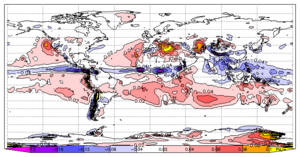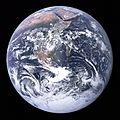Hadley cell facts for kids
The Hadley cell is a huge pattern of air movement around the Earth. It helps move heat from the Equator to other parts of the world. This movement creates many important weather patterns, like trade winds and deserts. It's named after George Hadley, a scientist who described it.
Contents
What is the Hadley Cell?
The Hadley cell is a major part of the Earth's atmospheric circulation. Think of it as a giant loop of air that moves heat and moisture around the planet. This loop starts near the Equator and reaches about 30 degrees latitude, both north and south.
How Does the Hadley Cell Work?
This amazing air circulation happens in a few main steps:
- Rising Air: Near the Equator, the sun's rays are very strong. This heats the ground and the air above it. Hot air is lighter, so it rises high into the atmosphere, sometimes up to 10 to 15 kilometers (about 6 to 9 miles) high. As this warm, moist air rises, it cools down. This cooling causes water vapor to form clouds and heavy rainfall. This is why tropical areas near the Equator often have lots of rain.
- Moving Poleward: Once the air has risen, it starts to flow away from the Equator. It moves towards the North Pole in the Northern Hemisphere and towards the South Pole in the Southern Hemisphere. This movement happens high up in the atmosphere.
- Sinking Air: As this air moves away from the Equator, it continues to cool and lose its moisture. By the time it reaches about 30 degrees latitude (both north and south), it's cool and very dry. This cool, dry air then sinks back down towards the Earth's surface.
- Returning Equatorward: When the air reaches the surface, it flows back towards the Equator. This completes the loop. As this air moves back, it picks up moisture, getting ready to rise again near the Equator.
What Does the Hadley Cell Create?
The Hadley cell is responsible for many important weather features around the world:
- Trade Winds: As the air flows back towards the Equator near the surface, it creates steady winds called trade winds. Sailors used these winds for centuries to travel across oceans.
- Tropical Rain Belts: The rising air near the Equator brings lots of rain. This creates lush rainforests and tropical rain belts in places like the Amazon and parts of Africa and Asia.
- Subtropical Deserts: The sinking, dry air at about 30 degrees latitude creates many of the world's major deserts. These include the Sahara Desert in Africa and the deserts in Australia. Because the air is sinking, it's very dry and doesn't allow clouds or rain to form easily.
- Jet Streams: The Hadley cell also plays a role in forming the jet streams, which are fast-moving currents of air high in the atmosphere.
Who Was George Hadley?
The Hadley cell is named after George Hadley (1685–1768). He was an English lawyer and amateur meteorologist. In 1735, he was the first person to describe how this large-scale air circulation works. His ideas helped scientists understand how heat is moved around the Earth and how global wind patterns are formed.
Images for kids
See also
 In Spanish: Célula de Hadley para niños
In Spanish: Célula de Hadley para niños




